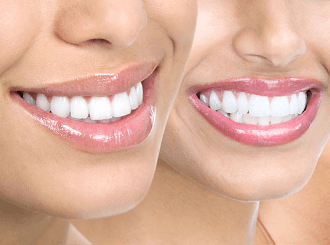
Dental porcelain can be sculpted to closely replicate the look of natural tooth enamel, while providing desirable strength and resilience. Porcelain crowns are an excellent choice when recreating the form and function of a damaged tooth, because a crown basically replaces the entire external portion of the tooth down to the gum level. Crowns are not limited to simply replacing the original tooth, but can be designed to create an even better esthetic appearance.
COSMETIC INLAYS AND ONLAYS
Inlays and onlays are indirect restorations that can be used to help an otherwise healthy tooth with a large filling. Inlays are placed within the grooves between the cusps (points) of a tooth, whereas onlays are placed within the grooves and over the cusp tips. As your dentist its our responsibility to help determine which restoration is best to help you achieve the smile you desire. Inlays and onlays can be used to replace old filings, and are more esthetically pleasing because they can be made to match a tooth’s natural color. Aside from improving a tooth’s appearance, inlays and onlays can strengthen the structure of a tooth because of their durability and longevity.
PORCELAIN CROWN CONSULTATION
Crowns can be selected for necessity or cosmetic reasons. No matter what the case, the first step is to schedule an obligation free consultation with our dental professionals. The dentist will examine your teeth and in some cases will immediately see that a crown is the best option. In other situations where the problems aren’t so obvious, you may need to express your concerns and discuss your future smile goals so both you and your dentist have all the facts.
THE HOWS AND WHYS OF PORCELAIN CROWNS
Porcelain crowns replace the exterior portion of a tooth to re–establish its original function and to create a natural appearance. Crowns are the treatment of choice in situations where tooth decay has destroyed most of the original tooth, when a traumatic event has caused damage, or in cases of severe enamel erosion. They are also an option for people who grind and clench their teeth so much that the original structure of their teeth has been compromised.
The great benefit to porcelain crowns is they can not only replicate the original tooth in function, but can be designed to look like the original–or even better. When patients select a porcelain veneer for cosmetic reasons, they’re usually covering up the front portion of the tooth that has some esthetic flaw. A porcelain crown is thicker than a veneer and, in some situations, this thickness is needed. A porcelain crown can be used for cosmetic reasons, but it’s best to seek the profesional advice from one of our dentists. So that you have all the options available presented to you and make an informed decision.
Crowns and veneers are situated and secured in the mouth in a similar fashion, using a light-sensitive resin placed between the original tooth and crown, and then hardening that resin with a special curing light. Partial crowns, often referred to as onlays, are a type of restoration or filling that covers one or more cusps. An inlay is similar to a filling but the work resides completely within the cusps on a tooth’s chewing surface. These restorations are much more conservative than crowns, and can be imperceptible from your natural tooth.
MAINTENANCE OF A PORCELAIN CROWN
Maintaining porcelain crowns is actually quite simple. Much like your original teeth, they require routine brushing with non-abrasive fluoride toothpaste and regular flossing. A follow-up appointment will be scheduled to evaluate the crowns shortly after they’re placed, so the dentist can review the work and see how your mouth is reacting to the crowns. Even if you think the crowns are successful, this follow-up appointment is an important part of your future oral health.

